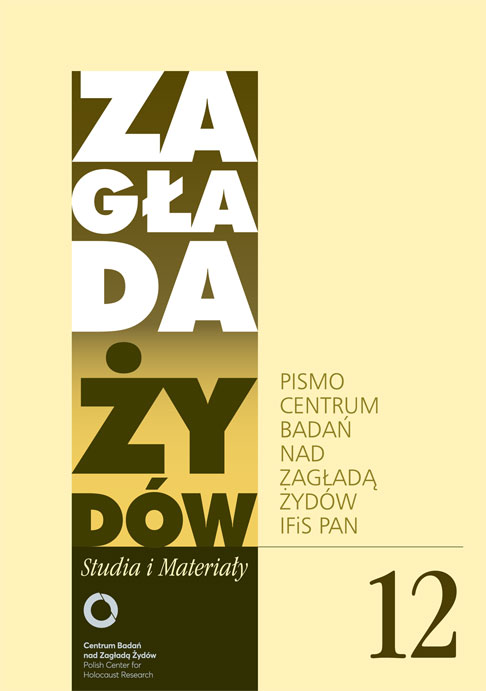Zagłada jako horror. Kilka uwag o literaturze polskiej 1985–2015
Zagłada Żydów. Studia i Materiały, Nr 12 (2016), Strony: 375-394
Data zgłoszenia: 2020-10-20Data publikacji: 2016-11-30
 https://doi.org/10.32927/ZZSiM.423
https://doi.org/10.32927/ZZSiM.423
Abstrakt
The author suggests that the depictions of the Holocaust in Polish literature of 1918–2014 should be categorized as horror. From the chronological perspective, Czapliński divides those thirty years into three shorter periods: 1) the initial period (from Claude Lanzmann’s Shoah and Jan Błoński’s essay “The Poor Poles Look at the Ghetto” to Wilhelm Dichter’s and Michał Głowiński’s memoirs) was dominated by white horror, which presented Jews as ghosts demanding a place in the Polish memory; 2) during the second period (from Marek Bieńczyk’s Tworki and Jan Tomasz Gross’ Neighbors until the end of the 2010s) the horror poetics was used to reveal those principles of pre-war and occupation-period normality which helped the Germans conduct the Holocaust and which conditioned the exclusion of Jews from the Polish circle of ‘normal humanity’; 3) during the third period (from Gross’s Golden Harvest until now) Jews return as the undead, violating the rules of distance and obliging Poles to physically touch the disgusting topic of the Holocaust. The contact with the Holocaust as something abhorring becomes a condition for self-knowledge, purging, and establishment of a new imaginary community.
Słowa kluczowe
Zagłada , horror , groza , obrzydliwość
Licencja
Prawa autorskie (c) 2016 Autor&"Zagłada Żydów. Studia i Materiały"

Utwór dostępny jest na licencji Creative Commons Uznanie autorstwa 4.0 Międzynarodowe.
https://creativecommons.org/licenses/by/4.0
Czasopismo publikowane jest w standardzie Diamond Open Access na licencji CC-BY-4.0 Deed - Uznanie autorstwa 4.0 Międzynarodowa - Creative Commons
Inne teksty tego samego autora
- Przemysław Czapliński, The Auschwitz Virus , Zagłada Żydów. Studia i Materiały: Nr Holocaust Studies and Materials (2017)
- Przemysław Czapliński, Prawda i co dalej , Zagłada Żydów. Studia i Materiały: Nr 15 (2019)
- Przemysław Czapliński, Wirus Auschwitz , Zagłada Żydów. Studia i Materiały: Nr 10 (2014)
Podobne artykuły
- Agnieszka Haska, „Na tej fabryce nie pracują Żydzi”. Nieznana historia pomocy , Zagłada Żydów. Studia i Materiały: Nr 19 (2023)
- Piotr Kendziorek, Martyna Jonas-Kowalik, Jutro wolni? Komuniści w ruchu oporu w getcie warszawskim , Zagłada Żydów. Studia i Materiały: Nr 19 (2023)
- Agnieszka Haska, Auschwitz z Auschwitz czyli przepis na bestseller , Zagłada Żydów. Studia i Materiały: Nr 16 (2020)
- Maria Ferenc, Aleksandra Bańkowska, „Czy może być jakieś odszkodowanie moralne za zatarcie wszelkich śladów tysiącletniego istnienia Żydów w Polsce?” Nieznane pisma Emanuela Ringelbluma z 1943 r. , Zagłada Żydów. Studia i Materiały: Nr 20 (2024)
- Jakub Petelewicz, Edward Kossoy (1913–2012) in memoriam , Zagłada Żydów. Studia i Materiały: Nr 8 (2012)
- Renata Piątkowska, Muzeum Żydowskie i Centrum Tolerancji w Moskwie , Zagłada Żydów. Studia i Materiały: Nr 9 (2013)
- Anne-Christin Klotz, Spiegel Jasmin, „To nie jest czas, by śnić?” Eksploracyjna lektura psychoanalityczno-historyczna wybranych snów na podstawie pamiętników ofiar Holokaustu w okupowanej Polsce (1939–1945) , Zagłada Żydów. Studia i Materiały: Nr 20 (2024)
- Jan Olaszek, Żydzi i armia Andersa. Przypadek Romana Zimanda , Zagłada Żydów. Studia i Materiały: Nr 20 (2024)
- Monika Stolarczyk-Bilardie, „Skoro Stolica Apostolska w 1942 wiedziała o tych wszystkich rzeczach, to dlaczego nie wykrzyczała [tego] światu?” Watykan wobec Zagłady: informacje z okupowanej Polski i ich odbiór za Spiżową Bramą, 1941–1943 , Zagłada Żydów. Studia i Materiały: Nr 20 (2024)
- Barbara Engelking, Israel Gutman, Z profesorem Israelem Gutmanem rozmawia Barbara Engelking , Zagłada Żydów. Studia i Materiały: Nr 9 (2013)
<< < 1 2 3 4 5 6 7 8 9 10 11 12 13 14 15 16 17 18 19 20 21 22 23 24 25 26 27 28 29 30 31 32 33 34 35 36 37 38 39 40 41 42 > >>
Możesz również Rozpocznij zaawansowane wyszukiwanie podobieństw dla tego artykułu.
 English
English
 Język Polski
Język Polski



 https://orcid.org/0000-0002-4805-6471
https://orcid.org/0000-0002-4805-6471

